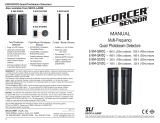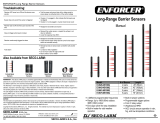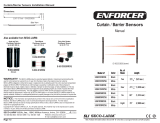Page is loading ...


ROBOGUARD V
User Manual
Trap International CC
Suite 5, 49 South Beach AVE
P.O .Box 38113
Point, 4069
Durban
South Africa
Phone 031.368.1266 • Fax 031.337.0138
www.roboguard.co.za

Table of Contents
Page:
The Roboguard System
Introduction to Roboguard and its Decoders. 1
The Roboguard
1. Roboguard Installation 2
2. Aligning the Beams for Optimal Performance 3
3. Modifying the Beam Arc for Optimal Performance 3
4. On-Board Computer Configuration 4
Operation Modes 5
Beam Strength Setting 6
5. Troubleshooting False Alarms 6
6. Batteries 7
7. Maintenance 7
8. Technical Configuration 8

R O B O G U A R D - U S E R M A N U A L
1
11
1
The Roboguard System
Thank you for purchasing The Roboguard Outdoor Surveillance System.
Roboguard is not only reliable, but also extremely robust. With correct installation
and occasional maintenance the system will provide you with years of trouble free
service.
How the Roboguard System Works:
The system comprises 2 areas of wireless electronic surveillance:
• The Roboguard (sensor)
• The Decoder (receiver).
The Roboguard System provides for various Decoders. HQ, KEYPAD and R2D2.
Your decoder will vary depending on the number of Roboguards you need to
monitor, how you connect to your alarm system, and what response provisions you
require for your alarm panel. Your dealer will advise you which decoder you need.
For the purposes of this manual, we will refer to the HQ (most common) but the
information pertains to any decoder.
The Roboguard (sensor): The Roboguard has two passive infra-red sensor beams.
One sensor at the top, and one at the bottom. These beams detect movement up to
20 metres away and within a radius of 110°. When both of these beams are triggered
within ½ a second of each other the Roboguard sends a signal to the receiver. This
arrangement allows only large objects to trigger the unit, allowing dogs and birds to
break the top or bottom beam without setting it off. In addition, each Roboguard
communicates with the receiver every 20 minutes to verify that it is operational, that
the signal strength is adequate and that the batteries are good.
Each Roboguard has a tamper switch that notifies the receiver if the cover is
removed.
The HQ (receiver): The receiver interprets the information from the sensor. When
triggered it will set off your alarm or sound the onboard speaker. This allows you to
see and hear when the unit has been triggered, tampered with, has poor signal
strength or low batteries. It identifies the exact Roboguard sensor location for you
and it can track up to eight units.

R O B O G U A R D - U S E R M A N U A L
2
22
2
1. Roboguard Installation
It is important to take some time to set up your system properly to optimize its
efficiency and to ensure long term peace of mind.
A) Choose a detection Zone for each of your Roboguard Sensors. Choose a
suitable location on your property that allows the Roboguard an
unobstructed view of the area to be monitored, and is within radio signal
distance from the HQ. (Should there be some doubt about the signal
strength, install the Roboguard per the following instructions and allow
the receiver to notify you if there is a problem.) Ensure there are no
sprinklers aimed at the guard.
B) Connect each Roboguard to the HQ by assigning it a detection zone
number (see your Receiver user manual).
C) Remove the cover screw with the Allan key supplied and remove the
battery cover from the Roboguard.
D) Position the base of the Roboguard at least 80 cm off the ground.
E) There are 4 mounting spaces provided in the back of the unit. 2 above
the battery rack and 2 below.
F) Drill 2 (or 4) mounting holes in the unit and corresponding holes on the
mounting surface and attach it to the mounting surface with screws.
G) Before replacing the cover ensure that each of the 2 sensors is still
correctly positioned, with the mounting screw over the middle line of the
adjustment slot. (see
Fig 1
) (They sometimes can move during shipping
or during the mounting process)
H) Your Roboguard is now fully operational.
Note: If you are unsure about the exact location that will be suitable for the
Roboguard you should temporarily mount it to a suitable pole and experiment by
moving it from place to place until you are satisfied with its performance. Then make
the permanent mounting and any other adjustments.
Fig 1: Sensor mounting screw in the centre of the adjustment slot.

R O B O G U A R D - U S E R M A N U A L
3
33
3
Fine Tuning Your Roboguard
Fine Tuning Your RoboguardFine Tuning Your Roboguard
Fine Tuning Your Roboguard
2. Aligning the Beams for Optimal performance.
All Roboguards are factory set to align the top and bottom sensors so that their
beams are horizontally parallel. If a unit is not detecting movement properly it may be
necessary to adjust the beams to suit their location. To correct the alignment you need
to perform a Walk Test. You will need a flat screwdriver.
A) Take the mobile HQ with you.
B) Remove the battery cover from the unit.
C) Ensure that each of the 2 sensors is correctly positioned, with the
mounting screw over the middle line of the adjustment slot. (
see fig 1
)
D) To enable the Walk Test Mode, disconnect the battery power for
4 seconds. (Insert a screwdriver between 2 batteries and twist to separate
them)
E) In Walk Test Mode the sensors will emit a ‘buzzing’ noise when
triggered. The top sensor will buzz twice and the bottom sensor once.
When both beams are triggered you will hear 3 buzzes.
F) Walk from left to right across the front of the Roboguard and back again
(not towards and away from the Roboguard). If you hear only one buzz,
the bottom beam is detecting but not the top beam. The top beam needs
adjustment.
G) To adjust the top beam, loosen the mounting screw and slide the sensor
up or down in the adjustment slot. As with a see-saw, sliding the sensor
up will lower the beam, and sliding the sensor down will raise the beam.
H) Make small adjustments and continue testing until you hear three buzzes.
(Note that a 1 mm adjustment to the sensor will result in a 1 metre
adjustment to the beam at 10 metre distance.)
I) Secure the sensor with the mounting screw and replace the battery cover.
The Roboguard will exit Walk Test Mode after 20 minutes.
J) Should you hear only two buzzes when conducting the Walk Test, the
top beam is detecting you but not the bottom. The bottom beam needs
adjustment as described above.
3. Modifying the Beam Arc for Optimal performance.
Each of the 2 sensors in the Roboguard emits 11 beams 10° apart to provide an arc of
detection of 110°. (
see Fig 2 ).
You can block some of these beams in order to
focus your Roboguard on a more defined area or to avoid swaying palm leaves etc.
To block off beams you need to access the Main Lens.
You will need some black insulation tape.
A) To access the lenses, slide the Peak off the top of the unit and the
Fastener Ring off the bottom of the unit. (
see fig 4
)
B) Slide out the dark UV Stable Outer Lens to expose the white Main Lens.
C) The white Main Lens has 11 ‘windows’. You need to tape over the
windows you want to block. For example: If you need a detection arc of
90°, you will need to block off two end windows. (
see fig 3
)
D) Make sure you make the same changes to both lenses.

R O B O G U A R D - U S E R M A N U A L
4
44
4
E) Replace the outer lens and carefully replace the Fastener Ring and Peak.
Be sure that the Outer lens fits into the slots in the Fastener Ring and
Peak, and does not become pinched.
Fig 2: 11 sets of beams covering an arc of 110°
Fig 3: Blocking off sections of the main lens.
This image shows 2 windows being blocked off
to allow an arc of 90° to remain.
4. On-Board Computer Configuration.
The Roboguard sensor has an on-board computer that can be configured to perform
optimally in different settings and under specific conditions. There are 5 operation
modes and 3 beam strength settings. These can be adjusted by moving switches
located on the computer board behind each sensor.
To adjust the mode you need to take out the bottom sensor.
To adjust the beam strength you need to take out the top and the bottom sensor.
You will need a small screwdriver

R O B O G U A R D - U S E R M A N U A L
5
55
5
A) Remove the Battery Cover.
B) Remove the screw securing the bottom sensor, hold the sensor tab
between your thumb and index finger and gently pull it out. (make sure to
note the position of the screw in the adjustment slot so that when you replace the sensor
you return it to the correct position).
C) Turn the sensor over and remove the 2 cover screws and the cover.
D) Be careful not to touch the pyro-electric cell on the other side of the
computer board, with your fingers.
E) You will see 2 switch boxes on the computer board. One has 5 switches
and one has 2 switches. The default setting for all the switches is OFF.
F) To change a setting, move the switch with a small screwdriver.
G) When your adjustments have been made, replace the sensor cover, turn
the sensor over so the pyro-electric cell (eye) faces up, and gently slide
the sensor back into the Roboguard body, pushing it far enough to see
the hole for the securing screw in the adjustment slot.
H) Insert the securing screw and adjust the sensor to the original position in
the slot before tightening the screw.
I) If you have made adjustments to the beam strength, make the same
adjustments to the top sensor.
J) Replace the battery cover.
Operation Modes (5 Switch Box)
Switch 1: Delayed and Instant Mode
OFF: When the Roboguard sensor is triggered three times in rapid succession it will
shut down for 1 minute before becoming active again. If it is triggered during the
shutdown period it will delay for a full minute of no hits before becoming active. This
mode is good for high traffic areas as, after the first three signals, it allows people to
pass without constant signaling, until it reactivates. This mode also saves battery life.
ON: The Roboguard sensor will signal instantly, every time it is triggered.
Switch 2: Double Hit Mode
OFF: Normal operation
ON: The Roboguard sensor will wait for 2 beams in the array to be triggered
before sending a signal. This mode is good for areas with large foliage that may trigger
one of the beams and cause false alarms. Not recommended for critical areas as an
intruder may be able to pass through a single set of end beams without triggering the
unit.
Switch 3: Multiple Hit Mode
OFF: Normal
ON: The Roboguard sensor will wait for multiple beams in the array to be
triggered before sending a signal. This mode is normally used with high monkey or
Hadida traffic, but it is recommended to first try repositioning the Roboguard, and/or
blocking some beams before using this feature, as reaction time of the unit is
impaired.

R O B O G U A R D - U S E R M A N U A L
6
66
6
Switch 4: Quick Reaction Mode
OFF: Normal – The top and bottom beams must be triggered within a ½ second of
each other to send a signal to the HQ.
ON: Quick Reaction Mode decreases this to a ¼ second. This works well when
used in small areas as it decreases false alarms from moving laundry, leaves and
branches. It does, however, decrease sensitivity over large areas.
Switch 5: Decreased Sensitivity Mode
OFF: Normal
ON: This mode is used to filter out electronic interference from motors, radios
and electronics as well as fluctuations caused by reflections off hot and cold surfaces.
It is only recommended for specific industrial applications.
Beam Strength Setting (2 Switch Box)
Beam Strength can be adjusted as follows:
20 metre plus range: 1 – OFF 2 - OFF
20 metre range: 1 – ON 2 – OFF
10-15 metre range: 1 – ON 2 – ON
Note
: The Roboguard responds best when set to the correct range. In smaller areas,
reduce the beam strength.
5. Troubleshooting False Alarms
The Roboguard sensors react to changes in movement, light and temperature that
occur within their field of view. It is therefore important that the Roboguard is not
installed in a position that inadvertently causes the unit to trigger a false alarm.
This can occur if:
• The unit is exposed to sunlight reflecting off water or glass.
• The unit is exposed to warm/cold thermals off surfaces, such as tar.
• The unit is mounted to a moving structure.
• There is moving vegetation between the unit and a significant heat source, such as
the sun.
• The unit is struck by sprinklers.
• The unit is not properly configured to miss dogs and birds.
• The beams are not aligned properly.
Steps you can take to rectify these problems:
• Try to identify what is causing the false alarms.
• Cut back encroaching vegetation.
• Move the Roboguard to exclude the problem area.

R O B O G U A R D - U S E R M A N U A L
7
77
7
• The Roboguard does not need to cover a large area if it is efficiently covering the
section where someone can enter the area.
• Block off beams to exclude problem areas such as swaying palm leaves.
• Ensure the sensors are secured in the correct position (see: Aligning the Beams for
Optimal Performance)
• In some cases the Roboguard may need to be reconfigured to perform optimally
under specific conditions. (see: On-Board Computer Configuration. Start by
resetting to the default Mode settings, but leave switch 1 ON, for Instant Mode)
• If you are unable to solve your problem, please contact your Roboguard dealer.
6. Batteries
Your Roboguard is supplied with 8 x C size alkaline batteries. These batteries should
last for a minimum of 3 years. Dry cell batteries should last a minimum of 1 year.
Your receiver will inform you when the batteries become weak as the Trouble Light
will start to flash. Remember that your unit will continue to operate normally and
reliably with weak batteries. Only when the batteries become really weak will the unit
become unstable. Take your time, don’t panic, Trouble is picked up way in advance.
Just change the batteries when you can. (see: Trouble Warning in your HQ User
Manual)
To Change Batteries:
• Remove the cover screw with the Allan key supplied and remove the battery cover
from the Roboguard.
• Remove all 8 batteries and replace them with size C batteries, preferably alkaline.
• Make sure the polarity is correct. There are polarity indicators ( +, - ) next to the
battery springs to assist you.
• Replace the Battery Cover and cover screw.
7. Maintenance
Roboguards require basic maintenance to ensure the system continues to perform
optimally.
• You should regularly inspect the unit and remove any signs of infestation (spiders,
ants, etc.). Ants are particularly destructive.
• Check the field of view of the units and clear any encroaching vegetation.
• Clean the lenses once a year, or more frequently if necessary. Use a soft cloth and
warm soapy water.
• Clean the outer shield with a damp cloth.
• Remove the sensor and clean the pyro-electric cell (eye) with a cotton bud. Be
careful not to touch the eye with your fingers. (to remove the sensor see: On-
Board Computer Configuration)
• If you live at the coast, the top and bottom computer boards should be cleaned
with thinners and sprayed with Tectyl every 3 years. (to access the computer
boards see: On-Board Computer Configuration)

R O B O G U A R D - U S E R M A N U A L
8
88
8
8. Technical Configuration
Fig 4: Roboguard 5 – Exploded View.
The various components that make up the Roboguard.

/



